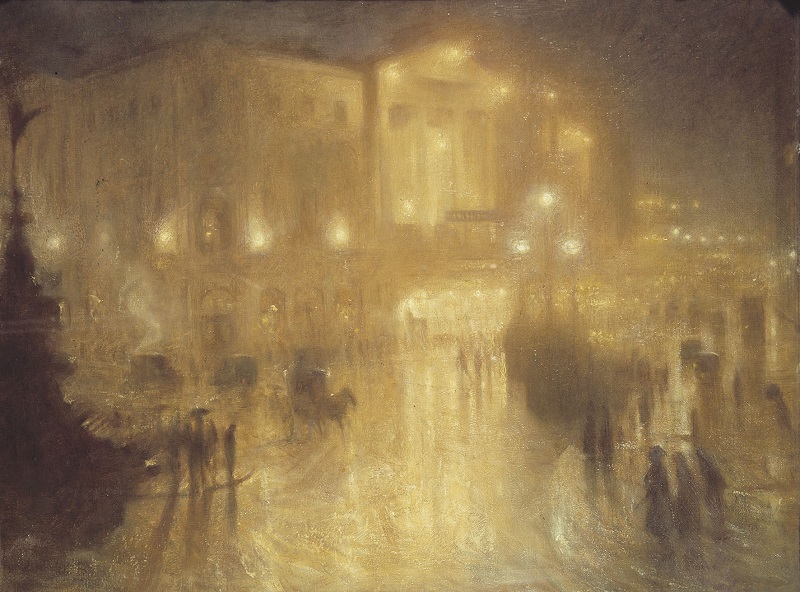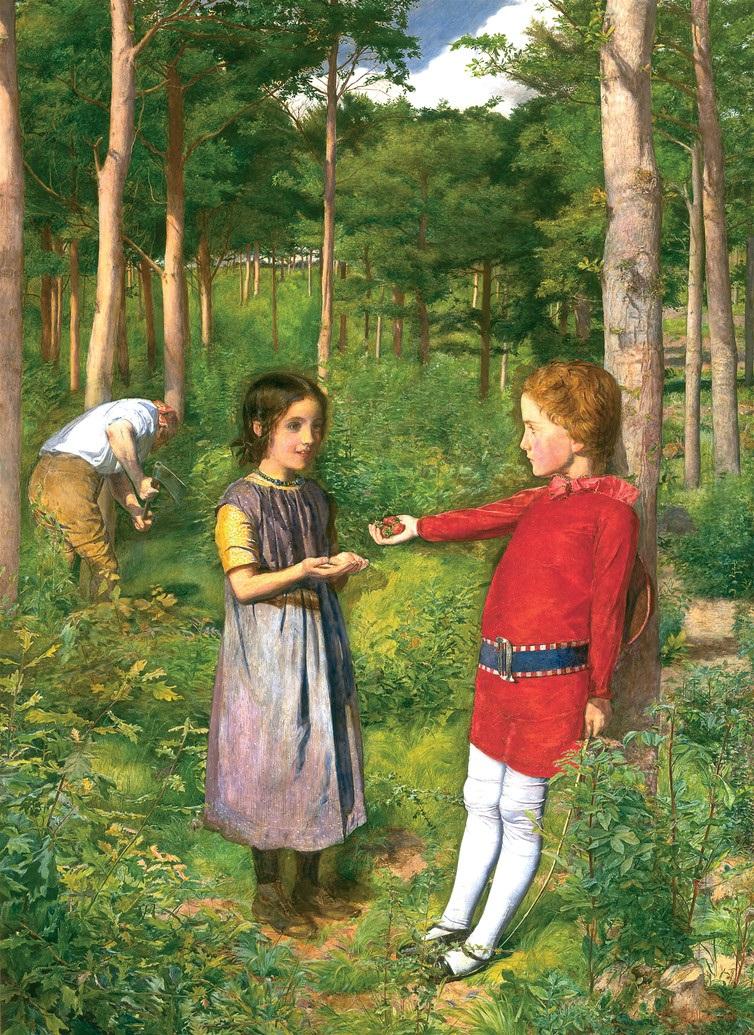Today we amuse ourselves with Facebook clips of talking cats, but in the 1850s they had stereographs, pairs of identical photographs that, viewed through special lenses, become suddenly and gloriously three-dimensional. Vistas open up as if by magic, the illusion of space all the more beguiling for its transience. The act of looking through a special pair of glasses is a little bit like peeping behind a curtain, the intimacy of the encounter adding a slightly voyeuristic frisson to all manner of subject matter from landscapes to mock-ups of popular paintings. Stereoscopic photographs have a dramatic presence that is potent even to our jaded 21st-century eyes, and must have been quite startling in the days when photography was just years, rather than decades, old.
Looking at a stereograph of a woodland scene, each leaf so crisply defined it might have been cut out and pressed into place, it seems truly remarkable that it was only 11 years earlier that the first photographic images were made. Ghostly and intensely atmospheric, those photographs made up for in ethereal beauty what they lacked in definition and clarity, but by the 1850s all this had changed: photography was a medium capable of recording the world in minute detail.
 Indeed it is this stereograph’s remarkable sharpness that strikes you, but seen next to a contemporaneous painting, The Woodman’s Daughter, 1850-51, by John Everett Millais (main picture), the ramifications of stereoscopic photography, easily dismissed as idle entertainment, seem much more profound (pictured above right: an example of a stereoscopic photograph by Clementina Hawarden, Isabella Grace on the Terrace, c.1861-2). You can see that Millais had been looking at photographs, the almost forensic details of the painting reminiscent of the clarity afforded by photography. The scene is dominated by woodland and allows only the smallest patch of sky, a compositional technique used by photographers to avoid the exposure problems that can result from vastly differing light sources. Inspired by photography, the painting represents a genuine attempt to see differently.
Indeed it is this stereograph’s remarkable sharpness that strikes you, but seen next to a contemporaneous painting, The Woodman’s Daughter, 1850-51, by John Everett Millais (main picture), the ramifications of stereoscopic photography, easily dismissed as idle entertainment, seem much more profound (pictured above right: an example of a stereoscopic photograph by Clementina Hawarden, Isabella Grace on the Terrace, c.1861-2). You can see that Millais had been looking at photographs, the almost forensic details of the painting reminiscent of the clarity afforded by photography. The scene is dominated by woodland and allows only the smallest patch of sky, a compositional technique used by photographers to avoid the exposure problems that can result from vastly differing light sources. Inspired by photography, the painting represents a genuine attempt to see differently.
Most obviously, photography presented painters with a useful new tool, providing a means of recording compositions and details for later reference, but here this represents just one aspect of the subtle but total infiltration of visual culture by photography. Part of the story is the painstaking work done by pioneers Robert Adamson and David Octavius Hill, whose panoramic photographs provided direct source material for Hill’s epic paintings of Edinburgh, but no less important is John Ruskin’s watercolour of The North-West Angle of the Facade of St Mark’s, Venice (undated), its close-cropped viewpoint informed specifically by photography.
The extent to which photography changed the way people, especially artists, viewed the world can only really be fully appreciated if we understand just how important paintings and printed images were at this time and the sheer excitement they could inspire. While we are used to the odd flurry of outrage provoked, usually, by the Turner Prize, a less cynical public response is far rarer.
 Tate Britain's dreary exhibition about history painting last year completely failed to address the bodice-ripping appeal of paintings like Charles Landseer’s The Plundering of Basing House, 1836. In contrast, the nature of the Victorian public's engagement with the painting is effortlessly conveyed here, through a series of stereographs that develop the narrative of Landseer's painting into three further scenes. They show the extent to which these sorts of history paintings could be experienced as moments of high drama, at an emotional pitch so intense that a whole narrative sequence could take flight in the viewer’s imagination, heightened by the three-dimensional effects of the stereoscope.
Tate Britain's dreary exhibition about history painting last year completely failed to address the bodice-ripping appeal of paintings like Charles Landseer’s The Plundering of Basing House, 1836. In contrast, the nature of the Victorian public's engagement with the painting is effortlessly conveyed here, through a series of stereographs that develop the narrative of Landseer's painting into three further scenes. They show the extent to which these sorts of history paintings could be experienced as moments of high drama, at an emotional pitch so intense that a whole narrative sequence could take flight in the viewer’s imagination, heightened by the three-dimensional effects of the stereoscope.
A similarly sensationalist impulse fuelled the popularity of Henry Wallis's 1856 portrayal of the death of Thomas Chatterton, the 18th-century poet who committed suicide aged 17. The painting toured the British Isles and attracted huge crowds, and so inevitably a stereoscopic image of the painting was issued, intended to be the first in a series illustrating Chatterton's life. Such spin-offs must have been incredibly profitable: the printmaker licensed to publish engravings of Wallis's painting went to court to have the stereoscope series stopped.
At a time when images of all sorts were more available than they had ever been, to people of all social classes, the invention of photography not only aided the reproduction and transmission of images, but added further to a rich and thriving visual culture. Instead of seeing the early years of photography as a period of immaturity, it is presented here as a medium bursting with confidence and faith in its own potential. The pictorialist impulses often interpreted as the insecurities of a new medium desperately trying to prove its worth are presented here as one side of a highly productive dialogue. Painters are shown reassessing the way they looked at the world, thinking differently about composition and the fall of light, in a direct response to photography (pictured above left: Arthur Hacker, A Wet Night at Piccadilly Circus, 1910). In turn, painters like Whistler inspired photographers to experiment with the expressive qualities of their medium.
- Painting with Light: Art and Photography from the Pre-Raphaelites to the Modern Age at Tate Britain until 25 September









![SEX MONEY RACE RELIGION [2016] by Gilbert and George. Installation shot of Gilbert & George 21ST CENTURY PICTURES Hayward Gallery](/sites/default/files/styles/thumbnail_125_x_125_/public/mastimages/Gilbert%20%26%20George_%2021ST%20CENTURY%20PICTURES.%20SEX%20MONEY%20RACE%20RELIGION%20%5B2016%5D.%20Photo_%20Mark%20Blower.%20Courtesy%20of%20the%20Gilbert%20%26%20George%20and%20the%20Hayward%20Gallery._0.jpg?itok=3oW-Y84i)





Add comment